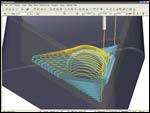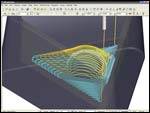Making the Technology Jump to Stay Competitive
Demands for faster, more complex mold tooling are met with a 3-D CAD and mold design system.
At the heart of North American manufacturing success in the past 25 years is the long-honored and specialized craft of mold design and manufacturing; however, now these tooling companies face new time-to-market pressures passed on from OEMs across multiple industries as well as cut-rate competition from overseas. K&K Tool Ltd. (St-Jean-sur-Richelieu, Quebec)—an injection and specialized moldmaker—recognized the trends early and made the technology jump to adjust and succeed.
Facing the Challenge
K&K Tool analyzed its customers' design processes and go-to-market needs and correctly projected its own need to dramatically boost design and manufacturing productivity.
The issues facing K&K Tool Ltd. included:
- OEMs demand more complex molds for new aesthetic and high-function parts
- Customers' move to 3-D part design makes 2-D mold design difficult and too slow
- Mold design group must increase production to meet OEM schedules
- More precise data needed for CNC machine tools in manufacturing
- Overseas competition
"Our OEM customers want to get to market first with in-novative new products. That drives more aesthetic and complex product designs, for which we have to make equally complex molds," explains Jean-Pierre Bernhard, project manager at K&K. "The simple toothbrush of the past is gone. They make more money from new stylized toothbrushes, but that means the mold to produce it has become much more complex for us to design and build."
In addition, during the past five years, K&K's customers have uniformly adopted parametric 3-D design systems. In the past, moldmakers had more time to build tooling because OEMs were hand drawing or at best—producing relatively simple designs in 2-D CAD. Armed with the new productive 3-D CAD systems, the OEMs' part design output increased dramatically—placing additional expectations on toolmakers that historically have relied on traditional 2-D design systems.
"Our customers are now cranking out part revisions daily and we needed a way to cope with that output and maintain our mold design in parallel with their product design—a key competitive get-to-market-first requirement," says Bernhard. "Shortened schedules to get complex tooling made 2-D design obsolete in our minds, and we had to find a modern 3-D CAD and mold design system."
The approach had to include the following steps:
- Get on even par with OEMs with 3-D design
- Boost drawing production to shorten manufacturing times
- Provide 3-D data in standard format for CNC use
- Maintain local competitive advantage with design of complex molds
Finding a Solution
Following a thorough evaluation of 3-D systems, K&K replaced its 2-D system with Solid Edge from UGS (Plano, TX). "Solid Edge had the unique functionality we need everyday in this industry, which was not available in other systems—including Rapid Blue shape creation technology and system libraries," notes Bernhard.
"Solid Edge's directly integrated mold tooling module reflects what we see as a commitment to our industry, just as the higher end UGS products NX and MoldWizard exemplify," Bernhard ex-plains. "I'm looking forward to further productivity gains once I begin using the new integrated Mold Tooling application. And Rapid Blue is very flexible and practical, and allows us to more easily create parting lines that are so important in mold design."
K&K receives IGES and STEP data from its OEM customers, easily imported and cleaned up in Solid Edge. Bernhard states, "We also receive a large amount of Parasolid data. Perhaps the best part about going with Solid Edge was that it is part of UGS, the owner of the Parasolid modeling kernel. UGS owns Solid Edge and UGS owns Parasolid. We felt very comfortable with that."
The move to 3-D Solid Edge has reduced major time delays verifying and correcting CNC programming needed for specialized machinery in manufacturing. The reuse of 3-D design data provides K&K with the precision and time saving it never could have imagined from its old 2-D data.
With Solid Edge, K&K now has a modern mainstream CAD system that can handle all of its data import, clean up, design, documentation and downstream applications. "And the directly integrated mold tooling module also has the potential to further win and maintain tooling business from our OEM customers," says Bernhard.
K&K's small handful of designers must keep design information flowing to its larger number of employees who actually make the molds. "With Solid Edge Mold Tooling we now have more tools to work with for communications with the shop floor. Molds produced in Solid Edge have allowed us to produce the required 2-D drawings for manufacturing twice as fast as with our previous system," Bernhard emphasizes.
Despite the explosion of complex products for which K&K must design companion complex tooling, it has increased productivity by using Solid Edge across the entire mold design process.
The results of K&K Tool's Solid Edge implementation included:
- Production molds produced within four weeks
- Drawing time cut in half
- Increased data transfer and collaboration between designers
- Simultaneous mold design changes as OEMs send daily changes
Bernhard states, "We have never declined a moldmaking job because the part was too complex and with Solid Edge Mold Tooling, we can continue with that highly regarded reputation among our customers."
Related Content
What is Scientific Maintenance? Part 2
Part two of this three-part series explains specific data that toolrooms must collect, analyze and use to truly advance to a scientific maintenance culture where you can measure real data and drive decisions.
Read MoreTips for Tackling Mold Design, Machining, Cutting Tool and Wear Challenges
Tips for tasks ranging from reducing risk in part design and taking advantage of five-axis machining to refining cutting tool performance and reducing wear with guiding and centering systems.
Read MoreHow to Fix Predicted Warpage Before It Happens with Windage and CAD Model Morphing
Applying windage and model-morphing techniques saved toolmaker/molder Sturgis Molded Products the time, cost, headaches of multiple part/mold design iteration loops, cumbersome cooling fixtures, and long molding cycles.
Read MoreTolerancing in Mold Design, Part 2: Using GD&T to Address Conventional Tolerancing Issues
Mold designers can achieve a single interpretation of workpiece functionality when following the American Society of Mechanical Engineers Geometric Dimensioning and Tolerancing standard.
Read MoreRead Next
How CAD/CAM Is Making a Programmer’s Job Easier
Arming yourself with the appropriate information will help you select the right software to help your shop work smarter not harder.
Read MoreHow to Use Continuing Education to Remain Competitive in Moldmaking
Continued training helps moldmakers make tooling decisions and properly use the latest cutting tool to efficiently machine high-quality molds.
Read MoreReasons to Use Fiber Lasers for Mold Cleaning
Fiber lasers offer a simplicity, speed, control and portability, minimizing mold cleaning risks.
Read More




















